
Полезные материалы за все 6 курсов / Учебники, методички, pdf / INBDEBooster Orthodontics
.pdf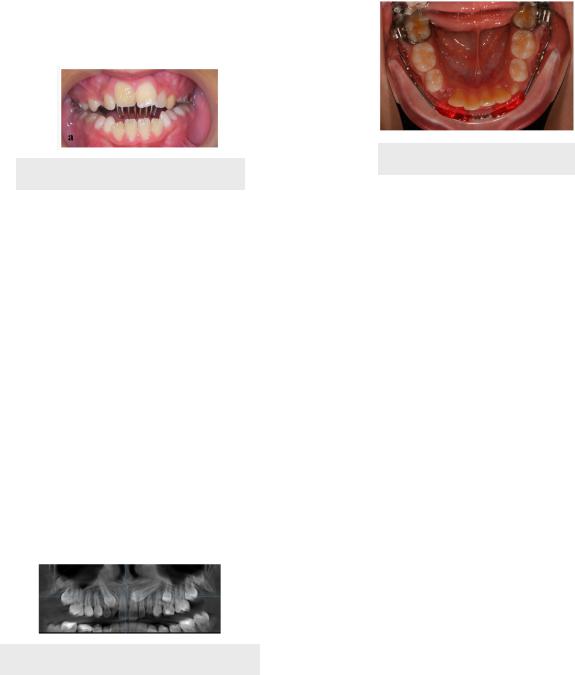
ORTHODONTICS |
31 |
Anterior Open Bite
•Often caused by thumb sucking or tongue thrusting
 Tongue thrusting
Tongue thrusting
 Patient places tongue anteriorly during swallowing
Patient places tongue anteriorly during swallowing
 Generalized spacing + proclined incisors
Generalized spacing + proclined incisors
 Thumb sucking
Thumb sucking
 Encourages a posterior cross bite and narrowing of maxilla
Encourages a posterior cross bite and narrowing of maxilla
 Proclined maxillary incisors + retroclined mandibular incisors
Proclined maxillary incisors + retroclined mandibular incisors
•Treatment → rake or blue grass appliance
 Restricts habitual behaviour
Restricts habitual behaviour
Figure 1.04 Rake Appliance
Impacted Teeth
•Maxillary canines are most commonly impacted (after 3rd molars)
•Suggested to extract primary canines to open a path of least resistance for permanent canine eruption
•3Hs - used to judge chance of canine impaction
•Horizontal angulation of canine
•Height of canine position
•Has the canine crossed the midline of the lateral incisor?
•Kurol’s Rule
•If canines have not passed the midline of the lateral incisor, there is 91% chance of self correction and eruption after
•If canine has passed the midline of the lateral incisor, 64% chance of self correction and eruption
Figure 1.05 Impacted Canines
Crowding
•Moderate Crowding (≥4mm crowding)
•Generally not a big concern
•Should not extract primary teeth to treat
•Treatment
•Lip bumper - allows lower incisors to lean forward by moving the lip out of the way
•Lower lingual holding arch (LLHA) - hold leeway space in place by prevent incisors from moving into the space
Figure 1.06 Lip Bumper
•Severe Crowding (≥8mm crowding)
•Treatment = serial extraction
•Consecutive removal of primary teeth in order to prevent impeded eruption of permanent teeth
•Contraindicated in patient with skeletal class II or III relationship
•Canine extracted first, then primary first molars, then 1st premolar
INBDE Booster | Booster Prep™
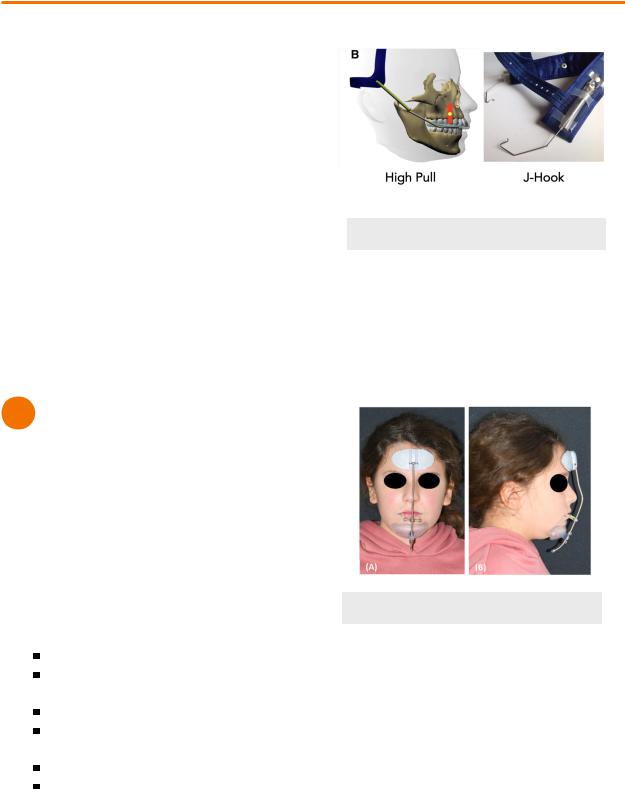
ORTHODONTICS |
32 |
COMPREHENSIVE TREATMENT
There are different types of orthodontic treatment that can depends on the source of the problem and the patients growth
• Skeletal correction
 Patient still growing → growth modification
Patient still growing → growth modification  Patient stopped growing → orthographic surgery
Patient stopped growing → orthographic surgery
•Dentoalveolar correction
 Non-extraction
Non-extraction
 Extraction
Extraction
•Most treatment includes both skeletal and dentoalveolar treatment
•Adult treatment
 No growth modification treatment
No growth modification treatment
 Should treat any periodontal conditions before orthodontic treatment
Should treat any periodontal conditions before orthodontic treatment
 Steel ligatures retain less plaque than elastomeric ligatures (if oral hygiene is a concern)
Steel ligatures retain less plaque than elastomeric ligatures (if oral hygiene is a concern)
1 Growth Modification
Growth modification can only be done during the period of growth for the patient. In females, this is usually between 8-13 years and for males, 10-15 years (with individual variation).
Headgear
•Treats skeletal class II patients during prepubertal growth
•Worn for 12-14h/day
•Restricts growth of the maxilla
 High-Pull
High-Pull
Treats class II open bite patients
Distalize and intrude maxillary molars
 Cervical-Pull
Cervical-Pull
Treats class II deep bite patients
Distalize and extrude maxillary molars
 J-hook
J-hook
Retracts canines and incisors
** for dentoalveolar treatment (not growth modifcation)
Figure 1.01 Headgear
Reverse headgear
•Treats skeletal class III maxillary deficiency patients as soon as 6-8 years
•Stimulates growth of the maxilla
•Protracts maxillary incisors
•Retracts lower incisors
•Clockwise rotation of mandible
Figure 1.02 Reverse Headgear
Chin cup
•Type of headgear
•Treats skeletal class III patients
•Restricts growth of the mandible
 But shown to be mostly ineffective
But shown to be mostly ineffective
INBDE Booster | Booster Prep™
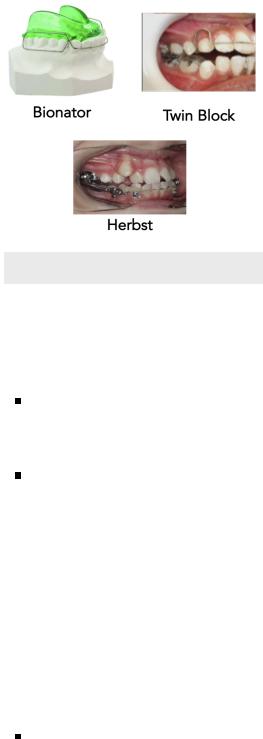
ORTHODONTICS
Functional appliance
•Treats skeletal class II patients (mandibular deficiency) by protruding the mandible so that facial tissue and muscles stretching modifies the condyles
 Bionator
Bionator
 Teeth guides separated by plastic which enforces advancement of the mandible→ encourages bone growth as condyles to fill in the space at the TMJ
Teeth guides separated by plastic which enforces advancement of the mandible→ encourages bone growth as condyles to fill in the space at the TMJ
 Removable, compliance important but often accepted
Removable, compliance important but often accepted
 Simple, durable
Simple, durable
 Activator
Activator
 Lingual flanges of appliance extends deep into lingual mucosa (approximately at the lower molars) → same effect as bionator
Lingual flanges of appliance extends deep into lingual mucosa (approximately at the lower molars) → same effect as bionator
 Removable, compliance important
Removable, compliance important
 Less accepted than bionator
Less accepted than bionator
 Herbst appliance
Herbst appliance
 Mandible pushed forward passively when patient closes mouth through piston and tube device
Mandible pushed forward passively when patient closes mouth through piston and tube device
 Fixed appliance
Fixed appliance
 Breaks easily
Breaks easily
 Twin block appliance
Twin block appliance
 Inclines of appliance encourages advancement of mandible for closure of the mouth
Inclines of appliance encourages advancement of mandible for closure of the mouth
 Removable or fixed
Removable or fixed
 More positive mandibular changes than activator or bionator
More positive mandibular changes than activator or bionator
 Mandibular anterior repositioning appliance (MARA)
Mandibular anterior repositioning appliance (MARA)
 Fixed appliance
Fixed appliance
 Durable, less bulky
Durable, less bulky
 More stable than herbst appliance
More stable than herbst appliance
 Twin block and Herbst are more effective for mandibular advancement
Twin block and Herbst are more effective for mandibular advancement
33
Figure 1.03 Functional Appliances
Palatal Expanders
• Schwarz
 Treats mild posterior crossbite
Treats mild posterior crossbite
 Jackscrew expander at the midline of palate
Jackscrew expander at the midline of palate
Parent/guardian uses a key to turn the jackscrew to expand the palate by 0.25mm
 Results in dental tipping mostly
Results in dental tipping mostly
Not true palatal expansion
 Removable
Removable
• W-arch
 Slow expansion by applying few hundred grams of force
Slow expansion by applying few hundred grams of force
 Mostly results in dental tipping (2/3) but also has skeletal expansion (1/3)
Mostly results in dental tipping (2/3) but also has skeletal expansion (1/3)
 Effective, comfortable
Effective, comfortable
 More effective than Schwarz
More effective than Schwarz
 Fixed appliance
Fixed appliance
• Quad helix
 4 helical loops that can apply more force than the W-arch in the anterior and posterior
4 helical loops that can apply more force than the W-arch in the anterior and posterior
Can activate loops depending if you want more anterior/posterior expansion
 Fixed appliance
Fixed appliance
• Hyrax appliance
 Uses jackscrew expander with orthodontic bands placed on 1st molars and 1st premolars
Uses jackscrew expander with orthodontic bands placed on 1st molars and 1st premolars
INBDE Booster | Booster Prep™
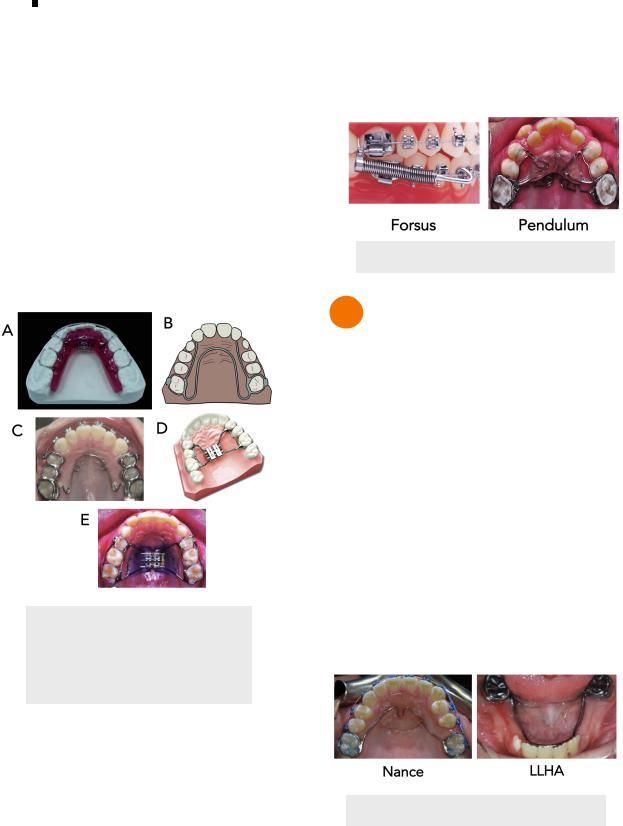
ORTHODONTICS |
34 |
100N force for one turn of jack screw to open mid palatal suture
 Skeletal expansion effective
Skeletal expansion effective
 Bulky = removal and placement more difficult
Bulky = removal and placement more difficult
 Compliance required for key turning
Compliance required for key turning
 Fixed appliance
Fixed appliance
• Haas appliance
 Uses jackscrew expander with acrylic pads that contact palatal mucosa
Uses jackscrew expander with acrylic pads that contact palatal mucosa
 Skeletal expansion effective
Skeletal expansion effective
 More difficult to clean
More difficult to clean
 Fixed appliance
Fixed appliance
• Transpalatal arch (TPA)
 Used for transverse anchorage, but could be used for dental expansion/constriction
Used for transverse anchorage, but could be used for dental expansion/constriction
Figure 1.04 Palatal Expanders
A - Schwarz, B - W-arch,
C - Quad Helix, D - Hyrax,
E - Haas
Other (Dentoalveolar Treatment)
• Forsus
 Teeth pushed by a pushrod
Teeth pushed by a pushrod
 Fixed appliance
Fixed appliance
 More maxillary restriction than other appliances
More maxillary restriction than other appliances
 Heavy maxillary and mandibular archwires
Heavy maxillary and mandibular archwires
• Pendulum
 Distalizes molars
Distalizes molars
 Pendex appliance can also add a jackscrew expander for palatal expansion
Pendex appliance can also add a jackscrew expander for palatal expansion
 Fixed appliance
Fixed appliance
 Only effects the maxillary arch
Only effects the maxillary arch
Figure 1.05 Forsus & Pendulum
2 Mixed Dentition Appliances
Nance
•Used on the maxillary arch as a space maintainer or anchorage device
•Bands on maxillary molars to keep them in their anterior-posterior positions
Lower Lingual Holding Arch (LLHA)
•Used as a space maintainer or anchorage device for the lower arch
 Prevents mesial drift of lower molars and lingual tipping of incisors
Prevents mesial drift of lower molars and lingual tipping of incisors
•Wire on lingual surface of incisors
Lip Bumper
•Used on lower arch
•Transfer lower lip pressure on lower incisors to the lower molars
Figure 2.01 Nance & LLHA
INBDE Booster | Booster Prep™
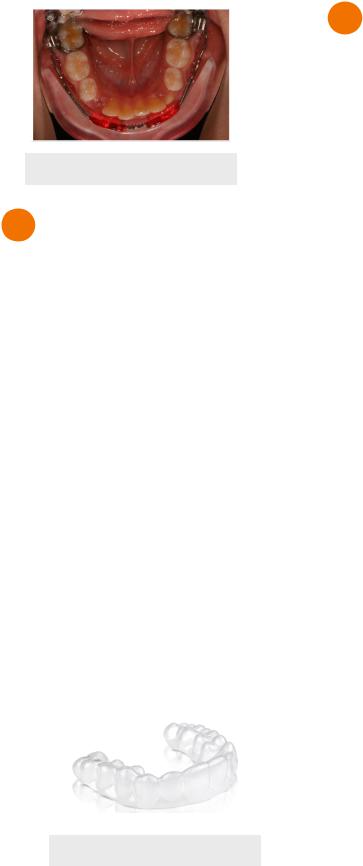
ORTHODONTICS
Figure 2.02 Lip Bumper
3 Permanent Dentition Appliances
Braces
•Can be used after permanent 1st molar erupts
•Fixed appliance
•Adults more likely to request invisible ceramic, lingual braces
•Steps for placement
1.Enamel prophylaxis - clean with pumice to remove pellicle and increase wettabilty
2.Etch enamel where bracket will be placed
3.Primer - chemically bonds resin used to bracket
4.Position brackets - usually on center of the crown, cure with adhesive resin
•Order of corrections
5.Teeth alignment and levelling the curve of speed
6.Anterior-posterior positioning of molars and space closure
7.Finishing and detailing
Aligners
•Series of removable clear tray aligners made by prescription developed by the provider
•Bonded attachments often needed
Figure 3.01 Aligners
35
4 Dentoalveolar Correction
Extraction
•Severe crowding
•Protrusive lips
•Minimal overbite/open bite
•Acute nasolabial angle
•Anterior recession or thin soft tissue
•Camouflage
Non-Extraction
•Mild or no crowning/spacing
•Retrusive lips
•Deep bite
•Obtuse nasolabial angle
INBDE Booster | Booster Prep™
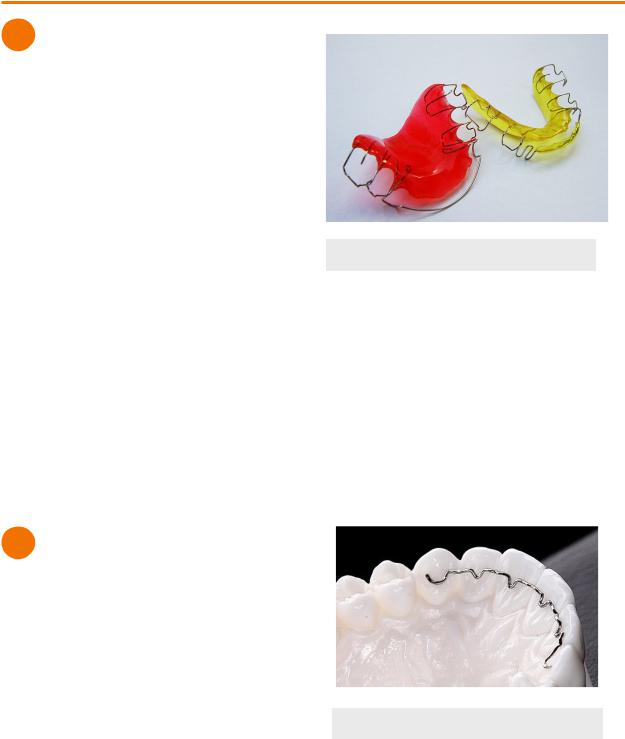
ORTHODONTICS
RETENTION
1 Introduction
Elastic Recoil
•Short-term dental changes
•Soft tissue fibre reorganization takes time after braces are removed
 PDL = 3-4 months
PDL = 3-4 months
 Gingival fibers = 4-6 months
Gingival fibers = 4-6 months
 Night time retainers recommended to limit relapse
Night time retainers recommended to limit relapse
 Supracrestal fibers = +1 year
Supracrestal fibers = +1 year
 Night time retainers recommended to limit relapse
Night time retainers recommended to limit relapse
•If teeth severely rotated → Supracrestal Fiberotomy (SCF)
 Rare
Rare
Differential Jaw Growth
•Long-term skeletal changes
•Relapse may occur from anterior-posterior and vertical growth
•Cheek, lip, or tongue pressure will push teeth into a different position
 Due to possible late mandibular growth shifting the equilibrium
Due to possible late mandibular growth shifting the equilibrium
2 Retainers
Hawley Retainer
• Upper retainer
 Incisors retention → Labial bow from canine to canine
Incisors retention → Labial bow from canine to canine
 Adam clasps → undercuts for molar retention (keep retainer ins place
Adam clasps → undercuts for molar retention (keep retainer ins place
 Acrylic on palate → connector, overbite, control
Acrylic on palate → connector, overbite, control
 Occlusal surfaces of teeth are free to erupt
Occlusal surfaces of teeth are free to erupt
• Lower retainer
 Acrylic on lingual
Acrylic on lingual
 Clip-on bar from canine to canine
Clip-on bar from canine to canine
36
Figure 2.01 Hawley Retainer
Lingual Bonded Retainer
•Wire bonded to the lingual surface of anterior teeth
 One flexible wire attached to each tooth
One flexible wire attached to each tooth
 Rigid wire on two teeth
Rigid wire on two teeth
 Usually mandibular canines or maxillary central incisors
Usually mandibular canines or maxillary central incisors
•Usually placed if large diastema of upper incisors was closed
•Usually placed if repositioned +2mm forward of lower incisors
Figure 2.02 Lingual Bonded Retainer
INBDE Booster | Booster Prep™
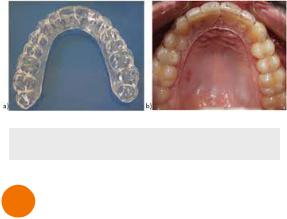
ORTHODONTICS |
37 |
Vacuum-Formed Retainer
•Clear plastic retainer
•More esthetic
•Posterior occlusion are separated which may influence occlusion
Figure 2.03 Vacuum-Formed Retainer
3 Relapse
Open Bite Relapse
•Prevent relapse by preventing over eruption off maxillary molars and intrusion of incisors
•Retainers recommended
 Upper Haley retainer with posterior bite block
Upper Haley retainer with posterior bite block
 Vacuum-formed retainer with thicker plastic on posterior occlusal surfaces separates the jaw
Vacuum-formed retainer with thicker plastic on posterior occlusal surfaces separates the jaw
• Poor oral habits should be controlled
Deep Bite Relapse
•Prevent relapse by preventing overeruption of incisors
•Prevent by using a Upper Hawley retainer with anterior bite plate
Class II Relapse
•Expect some amount of rebound after correcting a class II skeletal relationship  Especially when elastics were used
Especially when elastics were used
•Compensate by overcorrecting by 1-2mm during treatment
•Need for headgear/bionator + full-time retainer increased by the following:
 Severity of original Class II skeletal relationship
Severity of original Class II skeletal relationship
 Younger age at the time braces were debonded
Younger age at the time braces were debonded
Class III Relapse
•Mandibular growth very likely to continue and difficult to restrict after correction
•Compensate by overcorrecting by 1-2mm during treatment
•Surgery after complete growth might be the only solution
INBDE Booster | Booster Prep™
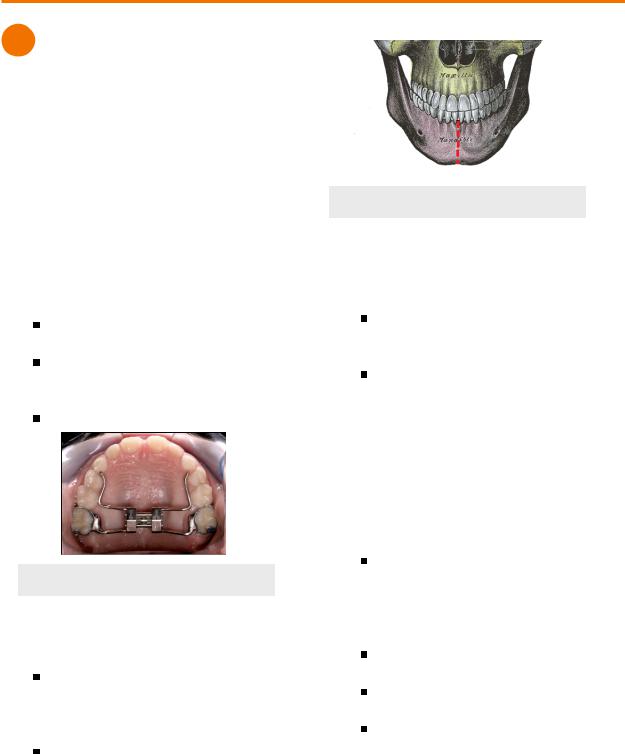
ORTHODONTICS |
38 |
SURGICAL ORTHODONTICS
1 Orthognathic Surgery
Orthognathic surgery is usually indicated when a patient’s condition is too severe to be corrected by orthodontics alone. This usually involves skeletal discrepancies. Such severe discrepancies include the following:
•Open bite
•Class III malocclusion
•Asymmetry
Transverse Correction
• Maxilla
 Surgical Assisted Rapid Palatal Expansion (SARPE)
Surgical Assisted Rapid Palatal Expansion (SARPE)
Can be done when the mid-palatal suture has not fused
If suture is fused, need to cut it back open again
 Constriction
Constriction
Limited in application and practicality
Figure 1.01 Palatal Expander
• Mandible
 Mandible Symphyseal Distraction
Mandible Symphyseal Distraction
Osteogenesis
Cutting through symphysis of mandible
to separate and allow bone to fill in =
expansion
 Constriction
Constriction
Limited in application and practicality
Vertical Repositioning Surgeries
• LeFort I Osteotomy
 Cut bone of maxilla above apices of teeth →allows for repositioning of entire maxilla
Cut bone of maxilla above apices of teeth →allows for repositioning of entire maxilla
Maxillary superior repositioning - move maxilla upwards = shortens midface/open bite correction
Maxillary inferior repositioning - move maxilla downwards = lengthen mid face/ deep bite correction
Anterior-Posterior Corrective Surgeries
• LeFort I Osteotomy
 Cut bone of maxilla above apices of teeth →allows for repositioning of entire maxilla
Cut bone of maxilla above apices of teeth →allows for repositioning of entire maxilla  Maxillary setback - Class II correction =
Maxillary setback - Class II correction =
brings maxilla posteriorly
Maxillary advancement - Class III correction = brings maxilla anteriorly
• Bilateral Sagittal Split Osteotomy (BSSO)
 Cutting through mandible on one or both sides in order to reposition the mandible
Cutting through mandible on one or both sides in order to reposition the mandible
Must be cautious of avoiding the inferior alveolar nerve
Mandibular setback - Class II correction = brings mandible posteriorly
Mandibular advancement - Class III correction = brings mandible anteriorly
INBDE Booster | Booster Prep™
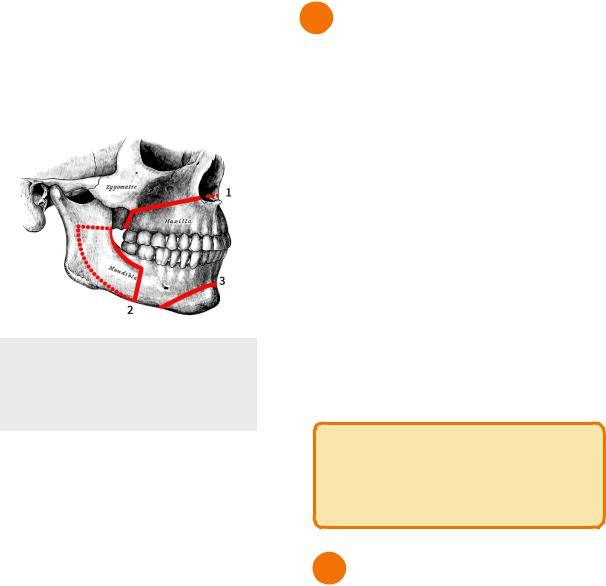
ORTHODONTICS
Genioplasty
•Improves the aesthetic condition of the chin
•Sliding genioplasty - can move the chin in all 3 dimensions
 Most common = most stable version of genioplasty
Most common = most stable version of genioplasty
Figure 1.02 Osteotomies
1)LeFort I
2)Bilateral Sagittal Split
3)Genioplasty
Post-Op Complication
• General Anesthesia
 Pneumatosis intestinalis - air in intestines + fever
Pneumatosis intestinalis - air in intestines + fever
 Alectasis - collapse of portion of lung + fever
Alectasis - collapse of portion of lung + fever
• LeFort Osteotomy
 Swelling, infection, bleeding
Swelling, infection, bleeding
•Bilateral Sagittal Split Osteotomy (BSSO)
 Swelling, infection, bleeding
Swelling, infection, bleeding
 Inferior alveolar nerve damage or paresthesia
Inferior alveolar nerve damage or paresthesia
 Very common, almost all patients will experience to some extent
Very common, almost all patients will experience to some extent
 Condylar sag - relapse after BSSO
Condylar sag - relapse after BSSO
 More potential for relapse with osteotomy than with distraction osteogenesis (more gradual)
More potential for relapse with osteotomy than with distraction osteogenesis (more gradual)
39
2 Relapse
Relapse can occur after orthographic surgery despite repositioning of the bones. This is because the soft tissues surrounding the bone place pressure on the bones and teeth to return to their original positions. Areas of the jaw have been placed in a hierarchy of stability to classify which surgical movements are the most and least likely to experience relapse.
• Most Likely for relapse
 Maxilla wide or down
Maxilla wide or down
 Mandible back
Mandible back
• Moderate likelihood for replace
 Maxilla up + mandible forward
Maxilla up + mandible forward
 Maxilla foward + mandible back
Maxilla foward + mandible back
 Maxilla fowards
Maxilla fowards
• Least Likely
 Maxilla up
Maxilla up
 Mandible foward
Mandible foward  Chin (any direction)
Chin (any direction)
INBDE Pro-Tip:
In general, there is more likelihood of relapse when surgery induces a greater amount of change.
3 Envelopes of Discrepancy
Envelopes of Discrepancy is term referring to the extent a tooth’s position can be changed through growth, orthodontics, or surgery. It is important to note that the envelopes of discrepancy are additive. That is, the amount of surgical movement permitted accounts for after growth modification has taken place, which is accounted for after orthodontic movement takes place.
Tooth Movement for Orthodontics
With orthodontics alone, teeth can moved up until the following amounts:
INBDE Booster | Booster Prep™
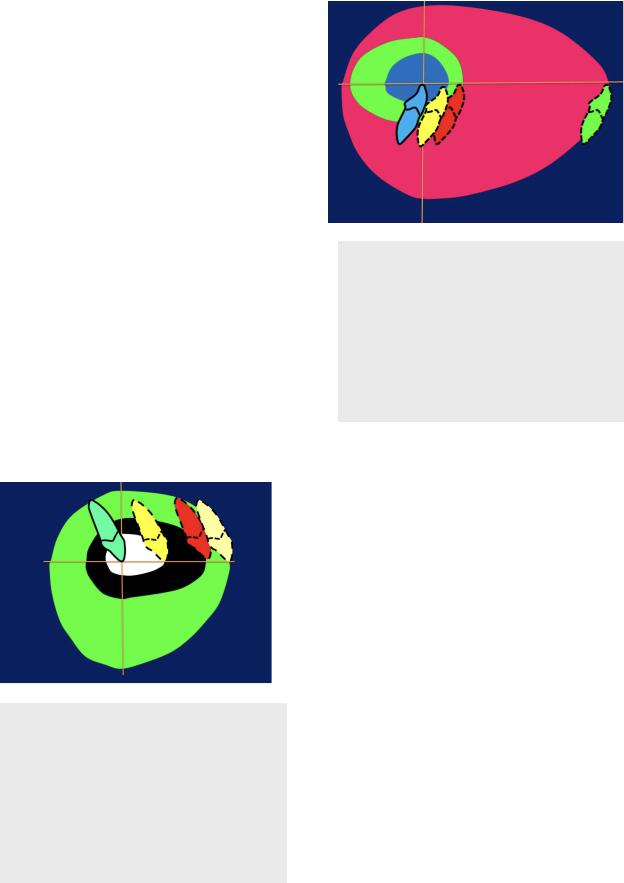
ORTHODONTICS
• Lower incisor
 Protraction - 2mm
Protraction - 2mm
 Retraction - 7mm
Retraction - 7mm
 Extrusion - 4mm
Extrusion - 4mm
 Intrusion - 2mm
Intrusion - 2mm
• Upper incisor
 Protraction - 5mm
Protraction - 5mm
 Retraction - 3mm
Retraction - 3mm
 Extrusion - 2mm
Extrusion - 2mm  Intrusion - 4mm
Intrusion - 4mm
Growth Modification
• Class II growth restriction
 Pulling maxilla + upper incisors back
Pulling maxilla + upper incisors back
 Pulling mand + lower incisors forwards
Pulling mand + lower incisors forwards
 Up to 5mm of change
Up to 5mm of change
• Class III growth restriction
 Pulling maxilla + upper incisors foward
Pulling maxilla + upper incisors foward
 Pulling mand + lower incisors back
Pulling mand + lower incisors back  Up to 3mm of change
Up to 3mm of change
Surgical Changes
•Surgery is most significant when the mandible is being set back
Figure 3.01 Envelopes of Discrepancy
(Maxilla)
White = Orthodontics
Black = Growth
Green = Orthodontic Surgery
Dotted lines = original tooth position Solid line = final tooth position
40
Figure 3.02 Envelopes of Discrepancy
(Mandible)
Blue = Orthodontics
Green = Growth
Pink = Orthodontic Surgery
Dotted lines = original tooth position Solid line = final tooth position
INBDE Booster | Booster Prep™
